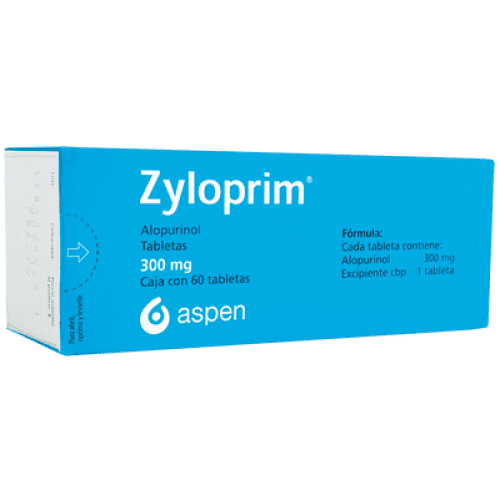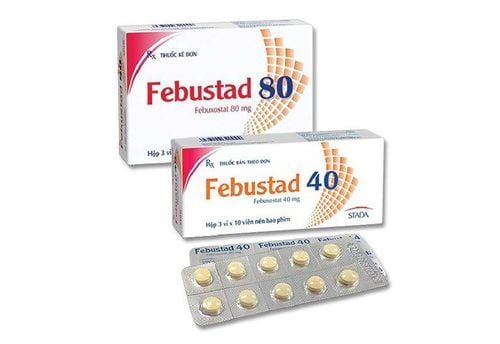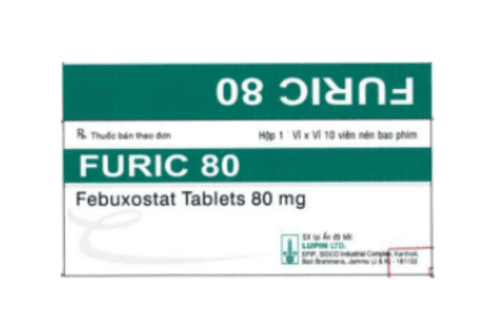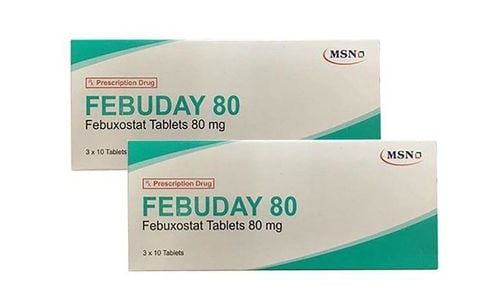This is an automatically translated article.
Uloxoric 80mg drug with the main ingredient is Febuxostat and the drug is used to treat gout and prevent hyperuricemia leading to tumor lysis syndrome. On the market today, there is a lot of information about the drug uloxoric 80mg, but it is still incomplete. To better understand what uloxoric is, what are the uses of uloxoric 80mg, let's learn more in the article below.
1. What is Uloxoric?
Uloxoric 80mg drug is a drug that works to reduce the amount of uric acid in the blood often used in the treatment of Gout. Uloxoric 80 mg, as the active ingredient Febuxostat, is a xanthine oxidase inhibitor and is used as an alternative when allopurinol has limitations in patients with renal impairment and has the potential to cause mild, severe, or very severe allergic reactions (although rare but possible). may result in death). Currently, on the market there are many drugs that reduce blood uric acid in the treatment of Gout. However, each patient will be suitable for each type of treatment differently.
Packing: A box of 3 blisters x 10 tablets
Dosage form: Film coated tablets
Uloxoric 80mg medicine contains the main ingredient Febuxostat 80mg and a mixture of excipients just enough.
1.1. Pharmacodynamics of the drug Uloxoric 80mg Pharmacotherapeutic group: Inhibits uric acid production and fights gout.
Mechanism of action: Uric acid is the end product of purine metabolism in humans and is formed by the process of hypoxanthine → xanthine → uric acid.
The above transformation steps will be catalyzed by the enzyme xanthin oxidase. Febuxostat is a 2-aryl thiazole derivative that effectively reduces serum uric acid levels by selectively inhibiting the enzyme xanthin oxidase.
Febuxostat is a non-purin selective inhibitor of the enzyme xanthin oxidase with an in vitro Ki value of less than one nanomolar.
Febuxostat will inhibit the oxidizing capacity and the formation of the enzyme xanthine oxidase.
During treatment febuxostat does not inhibit other enzymes involved in purine or pyrimidine metabolism and in particular, guanine deaminase, hypoxanthine guanine phosphoribosyltransferase, orotat phosphoribosyltransferase and orotidine decarboxylase monophosphate or purine nucleoside phosphorylase.
1.2. Pharmacokinetics of Uloxoric 80 mg In healthy subjects, the maximum plasma concentration (Cmax) and area under the curve (AUC) of febuxostat increased in a dose-proportional manner with single and multiple dosing from 10 mg - 120 mg.
At doses between 120 mg and 300 mg, the area under the curve (AUC) of febuxostat increased by a greater proportion. There is no significant accumulation when doses of 10 mg to 240 mg are taken orally every 24 hours. The half-life of Febuxostat (tfrac12;) is approximately 5 to 8 hours.
Pharmacokinetic/pharmacodynamic analysis was also performed in 211 patients with symptoms of hyperuricemia and gout, treated with febuxostat 40-240 mg daily.
In general, the febuxostat pharmacokinetic parameters to be estimated by analyzes are consistent with results obtained in healthy subjects, showing that healthy subjects represent the pharmacokinetic evaluation. /pharmacodynamics in a subset of patients with gout.
Absorption: Febuxostat is rapidly absorbed (t max after 1.0 to 1.5 h) and well absorbed (at least 84%). Following single or multiple oral doses of 80 mg and 120 mg once daily, peak concentrations (Cmax) were approximately 2.8-3.2 μg/ml and 5.0-5.3 μg/ml, respectively. The absolute bioavailability of the tablet form of febuxostat has also not been studied.
After you took multiple doses of 80 mg once daily or a single dose of 120 mg with a high fat meal, there was a 49% and 38% decrease in Cmax and a 18% and 16% decrease in AUC respectively.
However, no clinically significant changes in serum uric acid levels were observed in the trial (multiple doses of 80 mg). Thus, febuxostat can be administered without regard to meals.
Distribution: The net steady-state volume of distribution (Vss/F) of febuxostat ranges from 29-75 L following oral doses of 10-300 mg.
The plasma protein binding of febuxostat is approximately 99.2%, (mainly to albumin), and is unchanged at doses between 80 mg and 120 mg. The protein binding of the metabolite is active in the range of 82% to 91%.
Metabolism: Febuxostat is also extensively metabolized by conjugation via the uridine diphosphate glucuronosyltransferase (UDPGT) enzyme system and by oxidation via the cytochrome P450 (CYP) system.
Four pharmacologically active hydroxyl metabolites were also identified, of which three occurred in human plasma. In vitro studies with human liver microsomes have shown that oxidative metabolites are formed primarily by CYP1A1, CYP1A2, CYP2C8 or CYP2C9 and that the glucuronide febuxostat is formed mainly by UGT 1A1, 1A8 and 1A9.
Elimination: Febuxostat is also eliminated by both hepatic and renal routes. Following oral administration of an 80 mg dose of 14C-labeled febuxostat, approximately 49% of the administered dose was recovered in the urine as unchanged febuxostat (3%), the active acyl glucuronide (30%), and the oxidized metabolites. its and its conjugates (13%), and other unknown metabolites (3%).
In addition to urinary excretion, approximately 45% of the dose recovered in the feces was the parent febuxostat (12%), the active acyl glucuronide (1%), its oxidized and conjugated metabolites (25% ), and other unknown metabolites (7%).
2. What are the uses of Uloxoric 80mg?
Treatment of chronic hyperuricemia when urate deposition has occurred (including history or presence of tophi or gouty arthritis).
Prevention and treatment of hyperuricemia in adult patients undergoing chemotherapy for hematologic malignancies at moderate to high risk of tumor lysis syndrome (TLS).
Uloxoric is indicated in adults.
3. Side effects of Uloxoric 80mg
The following side effects have also been found:
Common:
+ Acute gout attack, headache.
+ Diarrhea , nausea .
+ Liver dysfunction .
+ Rash, edema.
Uncommon:
+ Weight gain, diabetes, hyperlipidemia.
+ Insomnia, decreased sex drive.
+ Dizziness, somnolence and hemiplegia,...
+ Atrial fibrillation, heart palpitations.
+ Increased blood pressure, red skin.
+ Cough, shortness of breath, bronchitis.
+ Abdominal pain, flatulence, dry mouth, constipation and digestive disorders,...
+ Gallstones, dermatitis, itching, erythema and urticaria,...
+ Joint pain, stiffness, tension muscle and bursitis.
+ Kidney failure, burning urine and blood in the urine.
+ Erectile dysfunction .
+ Chest pain, fatigue.
+ Decrease in the number of platelets, white blood cells, increase in creatinine and increase in blood potassium.
Rare:
+ Decrease in peripheral blood flow and thrombocytopenia.
+ Anaphylactic reaction.
+ Blurred vision, anorexia, weight loss.
+ Stress, tinnitus.
+ Pancreatitis, stomatitis.
+ Jaundice, hepatitis.
+ Stevens-Johnson syndrome, angioedema, generalized rash, erythema, exfoliative skin rash, erythematous vesicles, pruritic rash, measles-like rash and alopecia, sweating.
+ Rhabdomyolysis and joint stiffness.
+ Thirst, increased blood glucose.
If you experience any of the above symptoms, you need to immediately call your doctor, pharmacist or take the patient to the nearest clinic or hospital.
4. Drug interactions
Because the active ingredient febuxostat inhibits xanthine oxidase, it will increase the concentration of mercaptopurine/azathioprine when used simultaneously, causing severe toxicity.
Glucuronide inducers will reduce the effectiveness of Febuxostat.
Antacids containing aluminum and magnesium: reduce the absorption of Febuxostat.
Using a dose of 1 Uloxoric 80mg tablet with theophylline will increase the Cmax and AUC of theophylline. The safety of this has not been evaluated, so caution should still be exercised when combining them.
Co-administration with agents that induce glucuronic conjugation may increase or decrease the therapeutic effect of Uloxoric.
5. How to use uloxoric 80mg effectively
5.1. How to take Uloxoric 80mg is prepared in the form of tablets and should be taken whole with a glass of water. Do not take the medicine with other drinks, such as milk, coffee, soft drinks,...
You can take the medicine at any time of the day, but it should be taken at the same time every day to avoid forgetting the dose.
5.2. Dosage Dosage in patients with gout: The recommended dose of febuxostat is 80 mg once daily regardless of meals. If serum uric acid is above 6 mg/dL (357 μmol/L) after 2-4 weeks, febuxostat is recommended at a dose of 120 mg once daily.
Febuxostat fast acting allows recheck of uric acid levels in the blood after 2 weeks. The goal of treatment to reduce and maintain serum uric acid levels is below 6 mg/dL (357 μmol/L).
It is recommended to prevent gout flares for at least 6 months.
Tumor lysis syndrome: The recommended dose of febuxostat is 120 mg once daily regardless of meals. Febuxostat should also be administered 2 days prior to initiation of cytotoxic therapy and continued for at least 7 days, however treatment may be extended up to 9 days depending on chemotherapy duration based on assessment clinical price.
Elderly: No dosage adjustment is required for the elderly.
Patients with renal impairment: Efficacy and safety have not been fully evaluated in patients with severe renal impairment (creatinine clearance < 30ml/min).
No dosage adjustment is required in patients with mild or moderate renal impairment.
Patients with hepatic impairment: The efficacy and safety of febuxostat have not been studied in patients with severe hepatic impairment (Child Pugh Class C).
Gout: The recommended dose for patients with mild hepatic impairment is 80 mg. Limited information in patients with moderate hepatic impairment.
Tumor lysis syndrome: In phase III of the trial, subjects with severe hepatic impairment were also excluded. No dosage adjustment is required for patients with normal liver function.
Children: The safety and effectiveness of Febuxostat in children under the age of 18 years have not been established. No data available.
Note: The above dosage is for reference only. The specific dose also depends on the condition and the progression of the disease. To get the right dose, you need to consult your doctor or medical professional.
5.3. What to do in case of an overdose? In case of an emergency, call 911 immediately or go to the nearest local health station.
5.4. What to do if you miss a dose? Add dose as soon as you remember. However, if the interval between the next dose is too short, skip the missed dose and continue with your dosing schedule. A double dose should not be used to make up for a missed dose.
6. Be careful when using medicine and how to store it
6.1. Use in pregnant women and lactating women Pregnant women: It is not known whether the drug has adverse effects on pregnant women and fetuses. Should only be used when absolutely necessary. Consult your doctor immediately before use.
Lactating mothers: animal studies have also shown that the drug may be excreted in breast milk. However, there is no specific confirmation in humans. Care should be taken when using this object. Consult your doctor immediately before use.
6.2. People who drive and operate machinery When using the drug can lead to headache, dizziness, dizziness, ... affecting concentration and alertness. Care should be taken when using these objects.
6.3 . Other notes Use caution when using for people with cardiovascular disorders, congestive heart failure. When used to treat tumor lysis, clinical cardiovascular monitoring is required. Discontinue use immediately if severe hypersensitivity and allergic reactions occur. Medication should only be used when the acute gout attack has completely improved. Treatment of acute gout attacks with NSAIDs or colchicine is recommended. However, during the use of the drug, if an acute attack occurs, the drug should not be stopped. It is necessary to consult a doctor for each patient, and Febuxostat can be continued to reduce the frequency and severity of acute gout attacks. Safety for use in children under 18 years of age has not been established. Not recommended for use in organ transplant recipients. Liver function should be checked before using the drug for treatment. Due to the Lactose component, it should not be used for people with Lapp lactase deficiency or glucose - Galactose malabsorption. 6.4. Storage conditions Uloxoric 80mg Store in tightly closed packaging, in a dry place, the temperature does not exceed 30 degrees Celsius. Keep out of reach of children and pets in your home.
Please dial HOTLINE for more information or register for an appointment HERE. Download MyVinmec app to make appointments faster and to manage your bookings easily.













